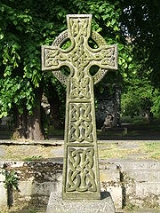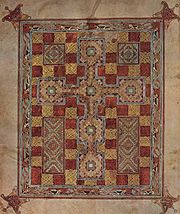
Celtic knot
Encyclopedia



Knot
A knot is a method of fastening or securing linear material such as rope by tying or interweaving. It may consist of a length of one or several segments of rope, string, webbing, twine, strap, or even chain interwoven such that the line can bind to itself or to some other object—the "load"...
s and stylized graphical representations of knots used for decoration, used extensively in the Celt
Celt
The Celts were a diverse group of tribal societies in Iron Age and Roman-era Europe who spoke Celtic languages.The earliest archaeological culture commonly accepted as Celtic, or rather Proto-Celtic, was the central European Hallstatt culture , named for the rich grave finds in Hallstatt, Austria....
ic style of Insular art
Insular art
Insular art, also known as Hiberno-Saxon art, is the style of art produced in the post-Roman history of Ireland and Great Britain. The term derives from insula, the Latin term for "island"; in this period Britain and Ireland shared a largely common style different from that of the rest of Europe...
. These knots are most known for their adaptation for use in the ornament
Ornament (architecture)
In architecture and decorative art, ornament is a decoration used to embellish parts of a building or object. Large figurative elements such as monumental sculpture and their equivalents in decorative art are excluded from the term; most ornament does not include human figures, and if present they...
ation of Christian monument
Monument
A monument is a type of structure either explicitly created to commemorate a person or important event or which has become important to a social group as a part of their remembrance of historic times or cultural heritage, or simply as an example of historic architecture...
s and manuscript
Manuscript
A manuscript or handwrite is written information that has been manually created by someone or some people, such as a hand-written letter, as opposed to being printed or reproduced some other way...
s, such as the 8th-century St. Teilo Gospels, the Book of Kells
Book of Kells
The Book of Kells is an illuminated manuscript Gospel book in Latin, containing the four Gospels of the New Testament together with various prefatory texts and tables. It was created by Celtic monks ca. 800 or slightly earlier...
and the Lindisfarne Gospels
Lindisfarne Gospels
The Lindisfarne Gospels is an illuminated Latin manuscript of the gospels of Matthew, Mark, Luke and John in the British Library...
. Most are endless knot
Endless knot
The endless knot or eternal knot is a symbolic knot and one of the Eight Auspicious Symbols. It is an important cultural marker in places significantly influenced by Tibetan Buddhism such as Tibet, Mongolia, Tuva, Kalmykia, and Buryatia...
s, and many are varieties of basket weave knot
Basket weave knot
The basket weave knots are a family of bend and lanyard knots with a regular pattern of over–one, under–one. All of these knots are rectangular and lie in a plane...
s.
History
The use of interlaceInterlace (visual arts)
In the visual arts, interlace is a decorative element found in medieval art. In interlace, bands or portions of other motifs are looped, braided, and knotted in complex geometric patterns, often to fill a space. Islamic interlace patterns and Celtic knotwork share similar patterns, suggesting a...
patterns had its origins in the artwork of the late Roman Empire. Knot patterns first appeared in the third and fourth centuries AD and can be seen in Roman floor mosaics of that time. Interesting developments in the artistic use of interlaced knot patterns are found in Byzantine architecture and book illumination, Coptic art, Celtic art, Islamic art, Medieval Russian book illumination, Ethiopian art, and European architecture and book illumination.
Spirals, step patterns, and key patterns are dominant motifs in Celtic art prior to the Christian influence on the Celts, which began around 450 A.D. These designs found their way into early Christian manuscripts and artwork with the addition of depictions from life, such as animal
Animal
Animals are a major group of multicellular, eukaryotic organisms of the kingdom Animalia or Metazoa. Their body plan eventually becomes fixed as they develop, although some undergo a process of metamorphosis later on in their life. Most animals are motile, meaning they can move spontaneously and...
s, plant
Plant
Plants are living organisms belonging to the kingdom Plantae. Precise definitions of the kingdom vary, but as the term is used here, plants include familiar organisms such as trees, flowers, herbs, bushes, grasses, vines, ferns, mosses, and green algae. The group is also called green plants or...
s and even human
Human
Humans are the only living species in the Homo genus...
s. In the beginning, the pattern
Pattern
A pattern, from the French patron, is a type of theme of recurring events or objects, sometimes referred to as elements of a set of objects.These elements repeat in a predictable manner...
s were intricate interwoven cords, called plait
Plait
A plait may refer to:* Plait, also called a braid, intertwined strands of, for example, textile or hair* Plait, now called a pleat, a fold of fabric, used in clothing and upholstery* Plait , a fold in the columella of a gastropod mollusc...
s, which can also be found in other areas of Europe
Europe
Europe is, by convention, one of the world's seven continents. Comprising the westernmost peninsula of Eurasia, Europe is generally 'divided' from Asia to its east by the watershed divides of the Ural and Caucasus Mountains, the Ural River, the Caspian and Black Seas, and the waterways connecting...
, such as Italy
Italy
Italy , officially the Italian Republic languages]] under the European Charter for Regional or Minority Languages. In each of these, Italy's official name is as follows:;;;;;;;;), is a unitary parliamentary republic in South-Central Europe. To the north it borders France, Switzerland, Austria and...
, in the 6th century. A fragment of a Gospel Book, now in the Durham Cathedral
Durham Cathedral
The Cathedral Church of Christ, Blessed Mary the Virgin and St Cuthbert of Durham is a cathedral in the city of Durham, England, the seat of the Anglican Bishop of Durham. The Bishopric dates from 995, with the present cathedral being founded in AD 1093...
library and created in northern Britain
Great Britain
Great Britain or Britain is an island situated to the northwest of Continental Europe. It is the ninth largest island in the world, and the largest European island, as well as the largest of the British Isles...
in the 7th century, contains the earliest example of true knotted designs in the Celtic manner.
Examples of plait work (a woven, unbroken cord design) predate knotwork designs in several cultures around the world, but the broken and reconnected plait work that is characteristic of true knotwork began in Northern Italy and Southern Gaul and spread to Ireland
Ireland
Ireland is an island to the northwest of continental Europe. It is the third-largest island in Europe and the twentieth-largest island on Earth...
by the 7th century. The style is most commonly associated with the Celtic lands, but it was also practiced extensively in England and was exported to Europe by Irish and Northumbrian monastic activities on the continent. J. Romilly Allen has identified "eight elementary knots which form the basis of nearly all the interlaced patterns in Celtic decorative art". In modern times Celtic Art is popularly thought of in terms of national identity and therefore specifically Irish, Scottish or Welsh.
Examples
See also
- Celtic CrossCeltic crossA Celtic cross is a symbol that combines a cross with a ring surrounding the intersection. In the Celtic Christian world it was combined with the Christian cross and this design was often used for high crosses – a free-standing cross made of stone and often richly decorated...
- Croatian wattleCroatian wattleThe Croatian wattle, known as the pleter or troplet in Croatian, is a type of interlace, most characteristic for its three-ribbon pattern. It is one of the most often used patterns of pre-romanesque Croatian art...
- Endless knotEndless knotThe endless knot or eternal knot is a symbolic knot and one of the Eight Auspicious Symbols. It is an important cultural marker in places significantly influenced by Tibetan Buddhism such as Tibet, Mongolia, Tuva, Kalmykia, and Buryatia...
- Islamic interlace patternsIslamic interlace patternsGeometric interlacing patterns are a subcategory of Islamic pattern and ornament. They can be considered a particular type of arabesque which developed from the rich interlace patterning of the Byzantine Empire, and Coptic art. One of the first Western studies of the subject was E. H...
- KhachkarKhachkarA khachkar or khatchkar is a carved, cross-bearing, memorial stele covered with rosettes and other botanical motifs. Khachkars are characteristic of Medieval Christian Armenian art found in Armenia.-Description:...
s - ArmeniaArmeniaArmenia , officially the Republic of Armenia , is a landlocked mountainous country in the Caucasus region of Eurasia...
n knotwork - Knot gardenKnot gardenA knot garden is a garden of very formal design in a square frame, consisting of a variety of aromatic plants and culinary herbs including germander, marjoram, thyme, southernwood, lemon balm, hyssop, costmary, acanthus, mallow, chamomile, rosemary, Calendulas, Violas and Santolina...
- Knots and graphsKnots and graphsKnots and graph theory are related in some simple ways.- Knot diagram :A knot in R3 , can be projected onto a plane R2 Knots and graph theory are related in some simple ways.- Knot diagram :A knot in R3 (respectively in the 3-sphere, S3), can be projected onto a plane R2 Knots and...
, a mathematical way of drawing Celtic knots - Oseberg styleOseberg styleThe Oseberg style is a Viking Era animal ornamentation in Norse art. -History:Oseberg style is named after the Oseberg ship grave, a well-preserved Viking age ship discovered in a large burial mound at the Oseberg farm near Tønsberg in Vestfold County, Norway...
- TriquetraTriquetraTriquetra originally meant "triangle" and was used to refer to various three-cornered shapes. Nowadays, it has come to refer exclusively to a particular more complicated shape formed of three vesicae piscis, sometimes with an added circle in or around it...
- Turk's head knotTurk's head knotA Turk's head knot is a decorative knot with a variable number of interwoven strands, forming a closed loop. The name is used to describe the general family of all such knots rather than one individual knot. While generally seen made around a cylinder, the knot can also be deformed into a flat,...
External links
- Reed's Knotwork Tutorial Probably the easiest method for designing basic Celtic knotwork
- Celtic Knotwork: the Ultimate Tutorial A look at the construction and mathematics of Celtic knots
- Draw Your Own Celtic Knotwork Comprehensive list of links to both knotwork tutorials and a knotwork bibliography
- Celtic Interlace - An Overview by Stephen Walker, reproduced with permission from Dalriada Magazine, 2000
- Vulturous Knotwork Online Celtic knot designer

